|
|
|
|
|
|
|
|
 |
|
PlanetScope • Hokkaido, Japan • September 25, 2021
|
|
In this week’s issue:
Satellites spot areas of Earth with unique and curious features, the Extremely Large Telescope is seen under construction in the mountains of Chile, and
wildfire season begins in the US Southwest.
|
|
|
|
|
FEATURED STORY
Curious Places
|
|
All places on Earth are curious, but some are more curious than others.
At least to us.
We find certain locations on the planet to be especially distinct because of some X factor—a colorful geological oddity, an area of cultural importance, an atypical pattern within a landscape.
Whichever the reason, the globe is chock full of them.
But every spot on Earth has a long, long history, meaning each is mystifying in its own right.
So we selected a handful that stood out to us for one curious reason or another.
|
 |
|
PlanetScope • Piqiang Fault, China • September 29, 2019
|
|
Google Earth explorers made a commotion a decade ago after locating mysterious patterns in China’s deserts.
Speculations varied widely, from maps of cities to extraterrestrial QR codes.
The likely answer, however, is still remarkable, though not quite as exciting as alien messages.
The massive symbols are believed to be calibration targets for Chinese spy satellites.
The satellites orient themselves in space by focusing their cameras on the etchings.
|
 |
|
Planetscope • Gobi Desert, China • April 5, 2022
|
|
Greenhouses trap heat—it’s why we’ve dubbed the process that’s warming Earth as the “ Greenhouse Effect.” So it’s ironic that the greatest concentration of greenhouses on Earth is so vast it’s actually cooling the local region by reflecting sunlight away.
|
 |
|
PlanetScope • Almería, Spain • November 29, 2021
|
|
That’s right, the jigsaw puzzle of white shapes covering this coastline are greenhouses—and there’s a lot of them.
The city of Almería along Spain’s southern coast is an agricultural powerhouse with 26,000 hectares of greenhouses to show for it.
The structures cover so much of the surrounding land that it’s been dubbed “ the Sea of Plastic.”
|
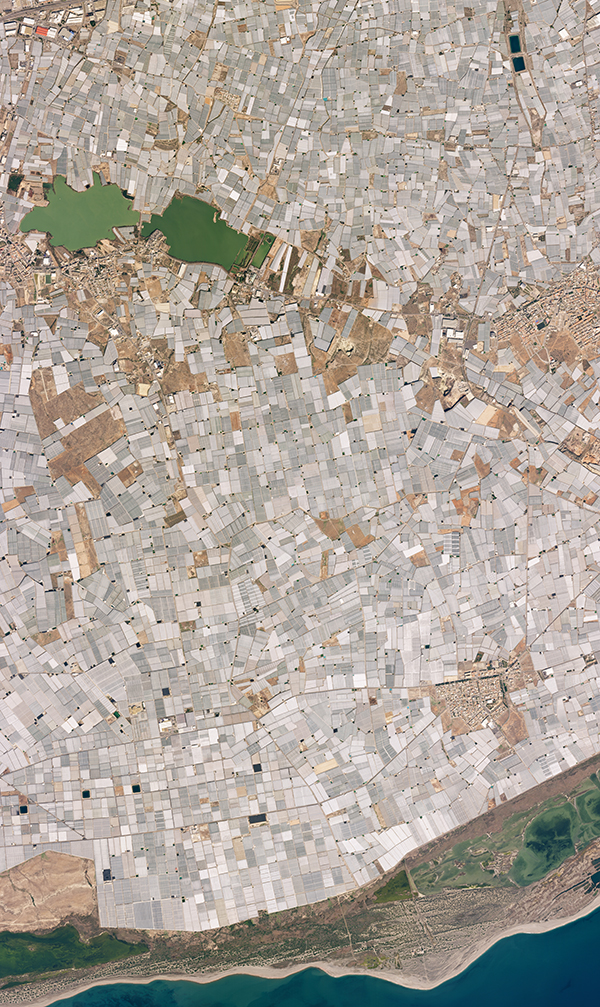 |
|
SkySat • Almería, Spain • November 13, 2017
|
|
You may think the entrance to the underworld would have pitchforks, three-headed dogs, and brimstone—but you’d be wrong.
The Gates of Hell are located in the desert of Turkmenistan and are about the size of an American football field.
The pit of fire—officially known as the Darvaza Gas Crater—is thought to have originated 50 years ago when a Soviet drilling rig collapsed and its leaking
methane was set on fire.
We’re not too eager to get close to the infernal entrance, so we’ll stick with the view from up here.
|
 |
|
PlanetScope • Darvaza Gas Crater, Turkmenistan • October 15, 2016
|
|
Deserts are usually described as desolate, but they often take on intriguing shapes and forms found nowhere else.
Dasht-e Kavir, or the Great Salt Desert, is filled with unique swirls.
The desert is located in a basin in the Iranian plateau and used to be a salt water ocean millions of years ago.
|
 |
|
PlanetScope • Dasht-e Kavir, Iran • March 14, 2022
|
|
|
Thick clouds roll into Svalbard’s arctic bays, settling between its icy fjords.
Atop one cliff, poking just above the cloud line, sits a satellite ground station.
If these don’t qualify the area as curious enough for you, then perhaps what’s underneath that barren arctic soil does.
Just below the clouds and jutting out of the frozen mountain’s edge is the entrance to the Svalbard Global Seed Vault, a doomsday safe containing nearly a million varieties of food crops.
It’s designed to protect thousands of years of agricultural progress in the event of an apocalyptic disaster.
The gene bank is located on the remote Norwegian archipelago of Svalbard near the northernmost town of Longyearbyen, a place that doesn’t see sunshine for 4 months of the year.
|
 |
|
PlanetScope • Svalbard Global Seed Vault, Norway • August 9, 2021
|
|
Move aside Venice and Amsterdam, because the city of canals may very well belong to Cape Coral, Florida.
The labyrinth-like city streets are built around a 400-mile system of canals connecting fresh water streams to the Gulf
of Mexico’s saltwater.
Within these backyard canals swim manatees, which are definitely some of the more interesting neighborhood critters we’ve heard of.
|
 |
|
PlanetScope • Cape Coral, Florida, USA • August 22, 2016
|
|
The Beatles find diamonds in the sky, but some miners uncover them from under lakes.
The Diavik Diamond Mine is located in the often frozen stretch of northern Canada.
The two pits over the lake were constructed in 2003 and the mine has been producing shiny diamonds ever since.
|
 |
|
PlanetScope • Diavik Diamond Mine, Canada • September 21, 2016
|
|
Bonus: There’s nothing technically curious about this sheep-filled, bucolic countryside in Wales, but we think any place that has a 3:1 sheep to human ratio deserves a spot on the list.
Plus we’re always fond of spotting animals from space.
We tried counting all of them but dozed off somewhere around 30.
|
 |
|
SkySat • Sheep, Wales • December 5, 2021
|
|
How curious did you find the list? We’ve barely scratched the surface of peculiar possibilities around the world, so let us know if you have any spots that fit the bill and we’ll take a look!
|
|
|
|
Extremely Large Telescope (ELT)
|
|
Earth is filled with all sorts of wonderful oddities, but there’s one place that’s even stranger and more mysterious: space.
We’re discovering this last frontier one probe, spaceship, and image at a time.
But the farther we look into the cosmic darkness, the bigger the equipment needed.
An international coalition headed by the European Southern Observatory is currently constructing the Extremely Large Telescope—quite the Extremely Self-Descriptive Name—in the Chilean highlands.
|
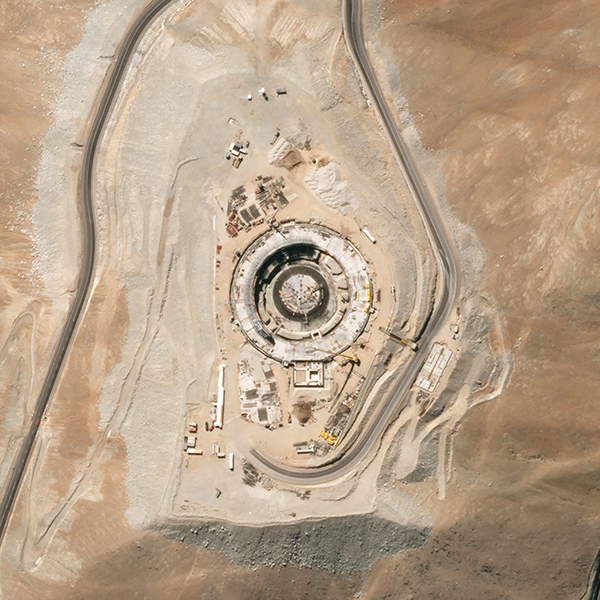 |
|
SkySat • ELT, Cerro Armazones, Chile • April 28, 2022
|
|
|
Once completed it will be the largest optical telescope ever made.
The Cerro Armazones mountain was chosen for its clear skies and low humidity, which have made Chile a popular destination for telescopes.
We photograph a lot of telescopes—we’re space enthusiasts after all—so we’ve been tracking ELT’s construction
closely.
We made a video of its development between June 2021 and April 2022, check out the gif below and the full video using 181 PlanetScope scenes here.
Call it space satellites photographing Earth telescopes photographing space if you'd like.
|
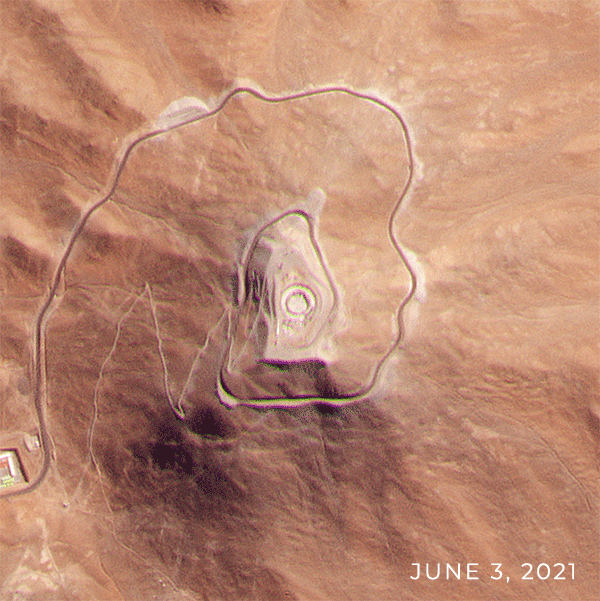 |
|
PlanetScope • ELT, Cerro Armazones, Chile • June 3, 2021 - April 20, 2022
|
|
|
|
Change of the Week: Wildfires
|
|
One of our busiest and least favorite times of the year here at Planet is wildfire season.
It was once considered a fifth season, confined to just a few months of the year.
But a severe megadrought paired with poor forest management and multiple effects of climate change have rewritten the rules.
Wildfire season today is less defined, more erratic, and happening earlier and with greater intensity.
On April 18, a wildfire broke out in Arizona’s Prescott National Forest and has burned nearly 10,000 acres (4,047 hectares) to
date.
Our Dove satellites captured the fire as it started and as it progressed through the landscape over the following days.
|
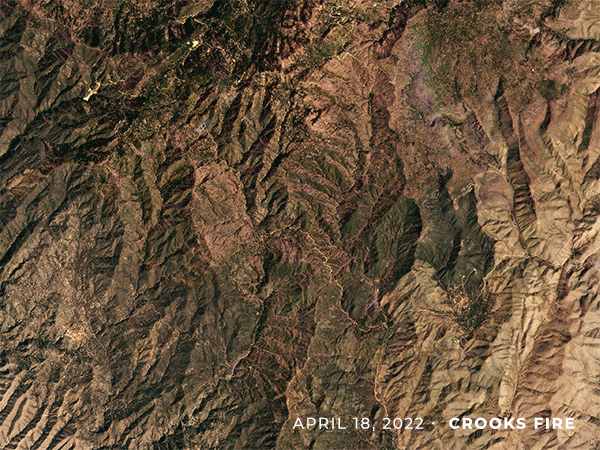 |
|
PlanetScope • Crooks Fire, Arizona • April 18 - 25, 2022
|
|
In northern New Mexico, just outside of Sante Fe, the Calf Canyon and Hermits Peak fires merged, forcing residents to evacuate as it raged through the dry landscape.
As of May 4, the fire has burned 160,000 acres (65,000 hectares) and is 20% contained.
|
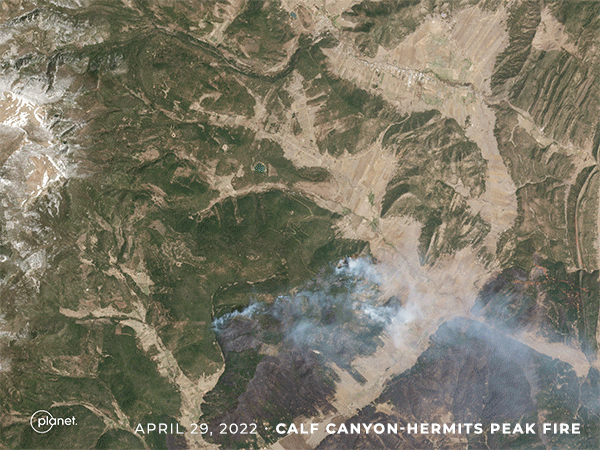 |
|
PlanetScope • Calf Canyon-Hermits Peak Fire, New Mexico, USA • April 29 - May 2, 2022
|
|
|
|
Snapshots Archive
|
|
Can’t get enough of Snapshots and eager to re-read all of our past issues? Well we’ve got the place for that! Head over to the Snapshots Archive to view all of our old issues, and be sure to share around if you enjoy!
|
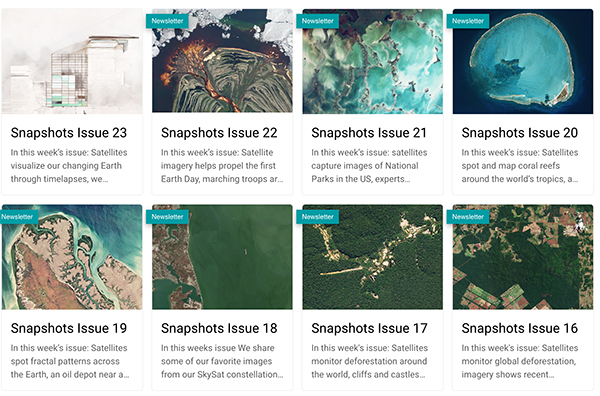 |
|
|
|
|
|